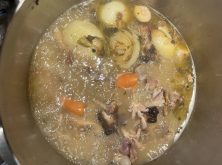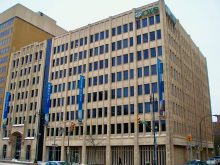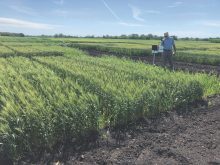The good name of agriculture has taken a few hits this spring. They don’t necessarily link to Canadian farms, but I’m sure even a global event making headlines has some impact with consumers wondering about what goes on with their food and the environment.
First, JBS meat packers in Brazil — the worlds largest meat processor owning one of two major beef plants in Canada — had to deal with a scandal involving meat inspectors in Brazil who were allegedly bribed to “permit the sale and export of rotten meat.”
Read Also

Gentle treatments for pain in the neck
Heading toward year-end, people unknowingly tense up against the cold and busyness, causing neck pain that can often be treated with appropriate support and gentle mobility, athletic therapist Kathlyn Hossack says.
Just that line alone “permit the sale and export of rotten meat” has to raise an alarm with a consumer concerned about the quality of products in Canadian meat counters. Consumers are already wondering about meat products laden with antibiotics and hormones and now they have to wonder if that bright pink package of ground beef is harboring some rotten burger. If I can just make it to A & W for lunch I should be safe and okay.
The fact is there is no Brazilian ground beef in Canadian retail stores and Canadian beef is fresh, healthy and safe as it ever was. But an event like a “rotten” meat scandal makes an impression… and not a good one. Brazil is working hard to clean up the mess and protect its $14-billion meat industry.
Consumer confidence
Next into the headlines, Robin Hood Flour, a Mother Corp. for wholesome, high quality, pure-as-the-driven snow wheat flour had to recall some of its products due to contamination from E. coli O121 bacteria. At first it was just a recall of 10 pound bags of flour in Western Canada, and then the recall went nation wide. Twelve people in B.C., four in Alberta, four in Saskatchewan and five in Newfoundland were among 25 cases of people getting sick due to that particular strain of E.coli.
So where did this come from? How does E.coli get into flour? Could it have some connection to stinky old raw pig manure that goes on the land, high herbicides residues in grains, or those millions of acres of genetically modified wheat across the prairies? It’s all pretty suspect. It could be one or a combination of those factors.
Again the fact is that Robin Hood is cranking out tons of healthy safe flour, there are no herbicide residues and there is no genetically modified wheat — at least not yet anyway. But for ag industry critics, the uninformed, even leery or questioning consumers E. coli in flour may make them at least pause with some concern. How safe is this stuff? Mom’s homemade, fresh baked bread and a glass of cold, wholesome milk almost share the same pedestal in the consumer’s mind. Don’t mess with bread and milk.
And then to add to the whole credibility concern about agriculture, another headline in the daily paper the day of this writing warns that “thawing farmer’s fields fuel climate change.” This has to do with tons of nitrous oxide, probably from the overuse of chemical fertilizers, floating off fields as the ground thaws creating holes in the ozone layer you could drive a bus through. I think I saw one hole in the sky this morning as I was driving over to A & W for a life saving breakfast. A & W is like a bombshelter in the hostile food world.
Environmental issues too
I wanted to learn more about how or why the annual spring thaw was “fuelling climate change,” so I called the lead researcher, Dr. Claudia Wagner-Riddle at the University of Guelph. She was helpful. I came away believing her research is sound, but the headline on the story in my daily paper may not have told the whole story.
Wagner-Riddle, with the University of Guelph School of Environment Sciences is studying greenhouse gas emissions from farmland, such as carbon dioxide (C02) and nitrous oxide (N20).
An important part of this project was determining a field-scale system for measuring nitrous oxide emissions from farmland. In the past they could take a frozen soil sample, thaw it out in the lab and measure gas release from the sample. But in this more recent work she developed a system that works on a field scale basis. She worked with farmland in Ontario and as well with the University of Manitoba on farmland in Manitoba. She had 14 years of research information from Ontario and nine years from Manitoba.
With that research information, she then gathered readings from 10 other locations in Canada as well as in the U.S., Japan, China and Germany. By extrapolating those findings to cropland world wide exposed to freeze/thawing cycles she came up with a figure.
Based on all the data, the freeze/thaw cycle worldwide produces about a teragram — one billion kilograms — of nitrous oxide per year. While the research might be out by a tonne or two here and there, the amount of nitrous oxide produced had not been qualified before.
So is every acre of western Canadian farmland contributing to the release of nitrous oxide into the atmosphere? Should we shut down farming?
No. The main contributor to the release of this harmful greenhouse gas is water-logged soils, particularly as they freeze and thaw. Parts of Manitoba and Ontario are very familiar with wet conditions, and the range might extend even much further across Western Canada after a very soggy 2016 growing and harvest season.
As you all remember from high school science class (I didn’t, I had to look it up) when soils become saturated soil microbes use nitrate — N to respire instead of oxygen — the process is called denitrification — resulting in the loss of nitrogen fertilizer to the atmosphere in the form of gases.
The fix is easy to describe, but not necessarily always easy to apply. Wagner-Riddle says maintaining late-season cover crops that use moisture, use up nitrogen and also provide some cover and insulation to reduce the degree of freezing is an important tool. Even just insuring there is crop stubble and residue on the soil helps to trap snow and again provides some measure of insulation against a real solid freeze. Pasture and hayland are less prone to denitrification than annual crop land and certainly compared to conventionally tilled farm land. The worst case scenario involves saturated soils that have been cultivated and have no cover.
And of course once you get into tillage that stimulates the loss of another greenhouse gas, carbon dioxide so fields could be releasing C02 as well as nitrous oxide.
Keeping crops growing and the ground covered will help reduce the risk of nitrous oxide emissions, says Wagner-Riddle but the dilemma for many producers — when the soil gets wet, some tillage is needed to get it dried out. Tile drainage might be an option in some situations, but it comes with a capital cost. And then on top of that most provincial governments in Western Canada really don’t understand tile drainage or have regulations in place to accommodate it.
Most farmers in Western Canada today are following some program of direct seeding or reduced tillage, but when conditions get wet, what do you do? I guess just be aware of the hazards that tillage causes, and where and when possible keep the tillage tool parked and some kind of cover on your land. Stop reading the paper might help too.
















